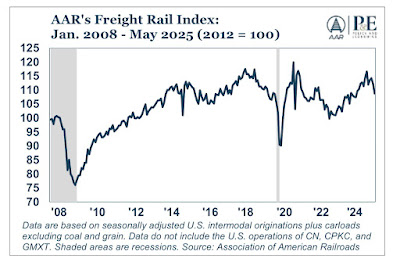- by New Deal democrat
The story of consumer prices in May is the same as it has been for the past several months: virtually everything except for shelter costs, and the even more lagging sector of transportation services, were somnolent. If the Fed wanted to, it could have declared victory many months ago.
To cut to the chase, for the month CPI rose 0.1%, core CPI rose 0.1%, and ex-shelter CPI was unchanged. On a YoY basis, CPI rose 2.4%, core CPI rose 2.8%, and ex-shelter CPI was up 1.5%.
Here is the month over month look at all three:
And here is the YoY look:
Of note, CPI less shelter has been under 2.5% for 2 full years, while headline and core inflation, which include shelter, have been decelerating very slowly and are currently at or very close to their lowest YoY increases in the past 4 years.
Within shelter, actual rent rose 0.2% for the month, and is up 3.8% YoY, while the fictitious Owners’ Equivalent Rent rose 0.3% for the month, and is up 4.2% for the year. Here’s what both of them look like in comparison with the FHFA house price index:
The YoY measure of each division of shelter CPI has been declining about -0.1% each month. Both are currently at their lowest YoY readings in over 3 years, and can be expected to continue to slowly disinflate, as they follow with a lag house prices as measured by, e.g., the FHFA purchase only index, which have continued to increase at basically a normal pre-pandemic pace for the past year:
As I wrote above, transportation services (mainly maintenance and repair as well as insurance) are even more lagging, since they react to the increased cost of vehicles and parts. Even here, the story is moderating (mainly due to airfares), as for the month they declined -0.2%, and on a YoY basis they are up only 2.5%, except for last month the best reading in over 4 years. Maintenance and repair costs declined -0.1%, and were up 5.1% YoY, while insurance (not shown) rose 0.7% in the month and was up 7.0% YoY:
The only other current problem child, with YoY readings over 4.0%, are electricity, up 0.9% for the month and up 4.5% YoY; and gas utility delivery, down -1.0% for the month but still up 15.3% YoY.
The former problem children of new and used vehicle prices continued to normalize, down -0.3% and -0.5% for the month, respectively; and up 0.4% and 1.8% YoY (below are normed to 100 as of just before the pandemic to better show the price increases during that time):
Finally, energy prices continued to disinflate, down -1.0% for the month and down -3.5% YoY (normed to 100 as of just before the pandemic):
In short, consumer inflation except for shelter continues to be not a problem at all. At their current pace of deceleration, it will take about another year for both actual rent and Owner’s Equivalent Rent to decline to under 3.0% YoY. With minor exceptions, everything else is already there and has been for several months.






























